A Comprehensive Approach to Identifying the Supply and Demand of Urban Park Cultural Ecosystem Services in the Megalopolis Area of Shanghai, China
Abstract
:1. Introduction
2. Material and Methods
2.1. Study Area
2.2. Data
3. Methods
3.1. Mapping the CES Supply and Demand of Urban Parks
3.1.1. Supply
3.1.2. Demand
3.2. Quantitative Analysis and Spatial Analysis
3.2.1. Bivariate Analysis of CES Supply and Demand
3.2.2. Spatial Cluster Analysis of CES Supply and Demand
- 1.
- Univariate Local Moran’s I
- 2.
- Bivariate Local Moran’s I
3.3. Spatial Scenarios of CES Supply–Demand
- (I)
- Quantity balance and space matching: includes areas where S = D and the spatial distribution is characterized by H-H or L-L. In these areas, the supply capacity and demand level are relatively consistent, so the dynamic equilibrium between supply and demand in changing environments needs to be further explored.
- (II)
- Quantity balance and space mismatching: includes areas where S = D, as well as areas where the spatial distribution is characterized by H-L or L-H. This region needs to optimize the distribution of supply and demand units, and adjust the CES flow of supply and demand to achieve a coordinated state.
- (III)
- Quantity imbalance and space matching: includes areas where S > D or S < D, as well as areas where spatial distribution is characterized by H-H or L-L. This region, which is mainly characterized by S < D, needs to increase its supply capacity while reducing the demand level in order to achieve coordination between supply and demand.
- (IV)
- Quantity imbalance and space mismatching: includes areas where S > D or S < D, as well as areas where the spatial distribution is characterized by H-L or L-H. This region needs to adjust both supply and demand levels and CES flow simultaneously.
4. Results
4.1. CES Supply and Demand of Urban Parks
4.1.1. CES Supply of Urban Parks
4.1.2. CES Demand of Urban Parks
4.2. Quantitative Analysis of CES Supply–Demand in Urban Parks
4.3. Spatial Analysis of CES Supply–Demand
4.4. Spatial Identification of Supply and Demand for Parks
5. Discussion
5.1. Supply–Demand Assessment of Urban Park CESs in Megalopolis Area
5.2. Methodological Advantages
5.3. Suggestions for Optimizing Urban Park CESs for Different Spatial Petterns
- (1)
- Regulation for supply and demand toward dynamic balance
- (2)
- Adjustment of capacity level for quantity balance
- (3)
- Adjustment of service flow for spatial match
5.4. Limitations and Future Perspectives
6. Conclusions
- (1)
- According to the results of quantitative analysis, the CES supply exceeds the demand (S > D), and the CES supply is less than the demand (S < D), in 39 sub-districts, respectively, accounting for 18.13% of all the sub-districts.
- (2)
- From the perspective of spatial analysis, 57 sub-districts show an H-H pattern, mainly concentrated in the inner urban area. There are 47 sub-districts showing an L-L pattern, mainly concentrated in the Chongming district and the southern suburb of Shanghai. Five sub-districts show an H-L pattern, scattered around the L-L sub-districts in the Songjiang, Pudong, and Qingpu districts.
- (3)
- Combining spatial and quantitative analysis, three types of spatial relationships can be identified in Shanghai. There are 136 sub-districts belonging to the type of quantity balance and space matching. Among the 79 sub-districts of unbalanced quantities, there are a total of 41 sub-districts belonging to the quantity imbalance and space mismatching type. Among them, only 15 sub-districts face a situation where supply is less than demand.
Author Contributions
Funding
Data Availability Statement
Conflicts of Interest
References
- Wang, Z.; Miao, Y.; Xu, M.; Zhu, Z.; Qureshi, S.; Chang, Q. Revealing the differences of urban parks’ services to human wellbeing based upon social media data. Urban For. Urban Green. 2021, 63, 127233. [Google Scholar] [CrossRef]
- de Groot, R.S.; Wilson, M.A.; Boumans, R.M.J. A typology for the classification, description and valuation of ecosystem functions, goods and services. Ecol. Econ. 2002, 41, 393–408. [Google Scholar] [CrossRef]
- Woodruff, S.C.; BenDor, T.K. Ecosystem services in urban planning: Comparative paradigms and guidelines for high quality plans. Landsc. Urban Plan. 2016, 152, 90–100. [Google Scholar] [CrossRef]
- Arsalan, M.; Chamani, A.; Zamani-Ahmadmahmoodi, R. Sustaining tranquility in small urban green parks: A modeling approach to identify noise pollution contributors. Sustain. Cities Soc. 2024, 113, 105655. [Google Scholar] [CrossRef]
- Yu, Z.; Yang, G.; Zuo, S.; Jrgensen, G.; Vejre, H. Critical review on the cooling effect of urban blue-green space: A threshold-size perspective. Urban For. Urban Green. 2020, 49, 126630. [Google Scholar] [CrossRef]
- Li, P.; Wu, W.; Yin, Y. Enhanced accessibility to park cooling services in developed areas: Experimental insights on the walkability in large urban agglomerations. Build. Environ. 2025, 272, 112665. [Google Scholar] [CrossRef]
- Yoshimura, N.; Hiura, T. Demand and supply of cultural ecosystem services: Use of geotagged photos to map the aesthetic value of landscapes in Hokkaido. Ecosyst. Serv. 2017, 24, 68–78. [Google Scholar] [CrossRef]
- Li, J.; Huang, Z.; Zhu, Z.; Ding, G. Coexistence Perspectives: Exploring the impact of landscape features on aesthetic and recreational values in urban parks. Ecol. Indic. 2024, 162, 112043. [Google Scholar] [CrossRef]
- Paracchini, M.L.; Zulian, G.; Kopperoinen, L.; Maes, J.; Schägner, J.P.; Termansen, M.; Zandersen, M.; Perez-Soba, M.; Scholefield, P.A.; Bidoglio, G. Mapping cultural ecosystem services: A framework to assess the potential for outdoor recreation across the EU. Ecol. Indic. 2014, 45, 371–385. [Google Scholar] [CrossRef]
- Li, Y.; Li, R.; Li, Q.; Zhao, X.; Zhao, P.; Yan, P.; Zhang, S.; Gu, L.; Xue, J. Study on the synergistic mechanisms of fungal biodiversity and ecosystem multifunctionality across vegetation diversity gradients. Sci. Total Environ. 2025, 964, 178563. [Google Scholar] [CrossRef]
- Guo, R.; Ann Diehl, J.; Zhang, R.; Wang, H. Spatial equity of urban parks from the perspective of recreational opportunities and recreational environment quality: A case study in Singapore. Landsc. Urban Plan. 2024, 247, 105065. [Google Scholar] [CrossRef]
- Pelletier, M.; Heagney, E.; Kovač, M. Valuing recreational services: A review of methods with application to New South Wales National Parks. Ecosyst. Serv. 2021, 50, 101315. [Google Scholar] [CrossRef]
- Peters, K.; Elands, B.; Buijs, A. Social interactions in urban parks: Stimulating social cohesion? Urban For. Urban Green. 2010, 9, 93–100. [Google Scholar] [CrossRef]
- Riechers, M.; Barkmann, J.; Tscharntke, T. Perceptions of cultural ecosystem services from urban green. Ecosyst. Serv. 2016, 17, 33–39. [Google Scholar] [CrossRef]
- Tian, T.; Huang, S.; Wu, Y.; Zeng, P.; Liu, Y.; Che, Y. Non-ecological factors affect human interaction with urban nature and perception of cultural ecosystem services. Sustain. Cities Soc. 2024, 112, 105643. [Google Scholar] [CrossRef]
- De Luca, C.; Calcagni, F.; Tondelli, S. Assessing distributional justice around Cultural Ecosystem Services (CES) provided by urban green areas: The case of Bologna. Urban For. Urban Green. 2024, 101, 128556. [Google Scholar] [CrossRef]
- Crossman, N.D.; Burkhard, B.; Nedkov, S.; Willemen, L.; Petz, K.; Palomo, I.; Drakou, E.G.; Martín-Lopez, B.; McPhearson, T.; Boyanova, K.; et al. A blueprint for mapping and modelling ecosystem services. Ecosyst. Serv. 2013, 4, 4–14. [Google Scholar] [CrossRef]
- Hosseini, S.J.F.; Laing, R. The role of plant clinics in sustainability of urban green spaces in Tehran. Int. J. Sustain. Dev. World Ecol. 2011, 18, 128–133. [Google Scholar] [CrossRef]
- Lee, G.; Hong, I. Measuring spatial accessibility in the context of spatial disparity between demand and supply of urban park service. Landsc. Urban Plan. 2013, 119, 85–90. [Google Scholar] [CrossRef]
- Zhang, Y.; Fu, B.; Sun, J.; Da Silva, R.F.B. Quantifying supply and demand of cultural ecosystem services from a dynamic perspective. Land Use Policy 2025, 148, 107414. [Google Scholar] [CrossRef]
- Liu, Z.; Huang, Q.; Yang, H. Supply-demand spatial patterns of park cultural services in megalopolis area of Shenzhen, China. Ecol. Indic. 2021, 121, 107066. [Google Scholar] [CrossRef]
- Riechers, M.; Barkmann, J.; Tscharntke, T. Diverging perceptions by social groups on cultural ecosystem services provided by urban green. Landsc. Urban Plan. 2018, 175, 161–168. [Google Scholar] [CrossRef]
- Nowak-Olejnik, A.; Działek, J.; Hibner, J.; Liro, J.; Madej, R.; Sudmanns, M.; Haase, D. The benefits and disbenefits associated with cultural ecosystem services of urban green spaces. Sci. Total Environ. 2024, 926, 172092. [Google Scholar] [CrossRef]
- Burkhard, B.; Kandziora, M.; Hou, Y.; Müller, F. Ecosystem Service Potentials, Flows and Demands—Concepts for Spatial Localisation, Indication and Quantification. Landsc. Online 2014, 34, 1–32. [Google Scholar] [CrossRef]
- Wu, J.; Jin, X.; Wang, H.; Feng, Z. Evaluating the supply-demand balance of cultural ecosystem services with budget expectation in Shenzhen, China. Ecol. Indic. 2022, 142, 109165. [Google Scholar] [CrossRef]
- Richards, D.R.; Law, A.; Tan, C.S.Y.; Shaikh, S.F.E.A.; Carrasco, L.R.; Jaung, W.; Oh, R.R.Y. Rapid urbanisation in Singapore causes a shift from local provisioning and regulating to cultural ecosystem services use. Ecosyst. Serv. 2020, 46, 101193. [Google Scholar] [CrossRef]
- Wu, X.; Liu, S.; Zhao, S.; Hou, X.; Xu, J.; Dong, S.; Liu, G. Quantification and driving force analysis of ecosystem services supply, demand and balance in China. Sci. Total Environ. 2019, 652, 1375–1386. [Google Scholar] [CrossRef] [PubMed]
- Zhai, T.; Wang, J.; Jin, Z.; Qi, Y.; Fang, Y.; Liu, J. Did improvements of ecosystem services supply-demand imbalance change environmental spatial injustices? Ecol. Indic. 2020, 111, 106068. [Google Scholar] [CrossRef]
- Guo, M.; Liu, B.; Tian, Y.; Xu, D. Equity to Urban Parks for Elderly Residents: Perspectives of Balance between Supply and Demand. Int. J. Environ. Res. Public Health 2020, 17, 8506. [Google Scholar] [CrossRef] [PubMed]
- Shen, J.; Du, S.; Huang, Q.; Yin, J.; Zhang, M.; Wen, J.; Gao, J. Mapping the city-scale supply and demand of ecosystem flood regulation services—A case study in Shanghai. Ecol. Indic. 2019, 106, 105544. [Google Scholar] [CrossRef]
- Xin, R.; Skov-Petersen, H.; Zeng, J.; Zhou, J.; Li, K.; Hu, J.; Liu, X.; Kong, J.; Wang, Q. Identifying key areas of imbalanced supply and demand of ecosystem services at the urban agglomeration scale: A case study of the Fujian Delta in China. Sci. Total Environ. 2021, 791, 148173. [Google Scholar] [CrossRef] [PubMed]
- Jin, C.; Weibin, Y.; Dongjin, H.; Xisheng, H. Supply and demand relationship and its spatial heterogeneity of urban parks in downtown area of Fuzhou. J. Zhejiang AF Univ. 2023, 40, 1300–1310. [Google Scholar]
- Bing, Z.; Qiu, Y.; Huang, H.; Chen, T.; Zhong, W.; Jiang, H. Spatial distribution of cultural ecosystem services demand and supply in urban and suburban areas: A case study from Shanghai, China. Ecol. Indic. 2021, 127, 107720. [Google Scholar] [CrossRef]
- Shen, Y.; Sun, F.; Che, Y. Public green spaces and human wellbeing: Mapping the spatial inequity and mismatching status of public green space in the Central City of Shanghai. Urban For. Urban Green. 2017, 27, 59–68. [Google Scholar] [CrossRef]
- Burkhard, B.; Kroll, F.; Nedkov, S.; Müller, F. Mapping ecosystem service supply, demand and budgets. Ecol. Indic. 2012, 21, 17–29. [Google Scholar] [CrossRef]
- Balázsi, Á.; Dänhardt, J.; Collins, S.; Schweiger, O.; Settele, J.; Hartel, T. Understanding cultural ecosystem services related to farmlands: Expert survey in Europe. Land Use Policy 2021, 100, 104900. [Google Scholar] [CrossRef]
- La Rosa, D.; Spyra, M.; Inostroza, L. Indicators of Cultural Ecosystem Services for urban planning: A review. Ecol. Indic. 2016, 61, 74–89. [Google Scholar] [CrossRef]
- Peng, J.; Wang, X.; Liu, Y.; Zhao, Y.; Xu, Z.; Zhao, M.; Qiu, S.; Wu, J. Urbanization impact on the supply-demand budget of ecosystem services: Decoupling analysis. Ecosyst. Serv. 2020, 44, 101139. [Google Scholar] [CrossRef]
- van Berkel, D.B.; Verburg, P.H. Spatial quantification and valuation of cultural ecosystem services in an agricultural landscape. Ecol. Indic. 2014, 37, 163–174. [Google Scholar] [CrossRef]
- Cai, Y.; Zhang, J.; Gu, Q.; Wang, C. An Analytical Framework for Assessing Equity of Access to Public Electric Vehicle Charging Stations: The Case of Shanghai. Sustainability 2024, 16, 6196. [Google Scholar] [CrossRef]
- Gai, S.; Fu, J.; Rong, X.; Dai, L. Users’ views on cultural ecosystem services of urban parks: An importance-performance analysis of a case in Beijing, China. Anthropocene 2022, 37, 100323. [Google Scholar] [CrossRef]
- Lang, Z.; Jing, L.; Li, F. Layout of urban green system: Characteristics and trend. City Palnning Rev. 2009, 33, 32–36. [Google Scholar]
- Liang, H.; Yan, Q.; Yan, Y.; Zhang, Q. Using an improved 3SFCA method to assess inequities associated with multimodal accessibility to green spaces based on mismatches between supply and demand in the metropolitan of Shanghai, China. Sustain. Cities Soc. 2023, 91, 104456. [Google Scholar] [CrossRef]
- Biernacka, M.; Kronenberg, J. Classification of institutional barriers affecting the availability, accessibility and attractiveness of urban green spaces. Urban For. Urban Green. 2018, 36, 22–33. [Google Scholar] [CrossRef]
- Fan, P.Y.; Chun, K.P.; Mijic, A.; Tan, M.L.; Liu, M.S.; Yetemen, O. A framework to evaluate the accessibility, visibility, and intelligibility of green-blue spaces (GBSs) related to pedestrian movement. Urban For. Urban Green. 2022, 69, 127494. [Google Scholar] [CrossRef]
- Lin, Y.; Zhang, M.; Gan, M.; Huang, L.; Zhu, C.; Zheng, Q.; You, S.; Ye, Z.; Shahtahmassebi, A.; Li, Y.; et al. Fine identification of the supply–demand mismatches and matches of urban green space ecosystem services with a spatial filtering tool. J. Clean. Prod. 2022, 336, 130404. [Google Scholar] [CrossRef]
- Willemen, L.; Verburg, P.; Hein, L.; van Mensvoort, M. Spatial Characterization of Landscape Functions. Landsc. Urban Plan. 2008, 88, 34–43. [Google Scholar] [CrossRef]
- Schröter, M.; Barton, D.N.; Remme, R.P.; Hein, L. Accounting for capacity and flow of ecosystem services: A conceptual model and a case study for Telemark, Norway. Ecol. Indic. 2014, 36, 539–551. [Google Scholar] [CrossRef]
- Guo, S.; Yang, G.; Pei, T.; Ma, T.; Song, C.; Shu, H.; Du, Y.; Zhou, C. Analysis of factors affecting urban park service area in Beijing: Perspectives from multi-source geographic data. Landsc. Urban Plan. 2019, 181, 103–117. [Google Scholar] [CrossRef]
- Schirpke, U.; Meisch, C.; Marsoner, T.; Tappeiner, U. Revealing spatial and temporal patterns of outdoor recreation in the European Alps and their surroundings. Ecosyst. Serv. 2018, 31, 336–350. [Google Scholar] [CrossRef]
- Sun, W.; Ren, J.; Zhai, J.; Li, W. ‘Just green enough’ in urban renewal: A multifunctional and pragmatic approach in realizing multiscale urban green space optimization in built-up residential areas. Urban For. Urban Green. 2023, 82, 127891. [Google Scholar] [CrossRef]
- Lynch, A.J. The role and potential of residential open space in a suburban green space network. Urban For. Urban Green. 2021, 58, 126971. [Google Scholar] [CrossRef]
- Emrich, C.T.; Cutter, S.L. Social Vulnerability to Climate-Sensitive Hazards in the Southern United States. Weather. Clim. Soc. 2011, 3, 193–208. [Google Scholar] [CrossRef]
- Stuerck, J.; Poortinga, A.; Verburg, P.H. Mapping ecosystem services: The supply and demand of flood regulation services in Europe. Ecol. Indic. 2014, 38, 198–211. [Google Scholar] [CrossRef]
- Anselin, L. Local indicators of spatial association—Lisa. Geogr. Anal. 1995, 27, 93–115. [Google Scholar] [CrossRef]
- Anselin, L.; Rey, S.J. Modern Spatial Econometrics in Practice: A Guide to Geoda, Geodaspace and Pysal; Geoda Press LLC: Chicago, IL, USA, 2014. [Google Scholar]
- Wentao, Y.; Xin, H.; Yuncai, W. Measurements of the supply and demand for the flood regulation ecosystem services of green infrastructure: A review. Acta Ecol. Sin. 2019, 39, 1165–1177. [Google Scholar]
- Mexia, T.; Vieira, J.; Príncipe, A.; Anjos, A.; Silva, P.; Lopes, N.; Freitas, C.; Santos-Reis, M.; Correia, O.; Branquinho, C.; et al. Ecosystem services: Urban parks under a magnifying glass. Environ. Res. 2018, 160, 469–478. [Google Scholar] [CrossRef] [PubMed]
- Assesment, M.E. Ecosystems and human well-being: Synthesis. Phys. Teach. 2005, 34, 534. [Google Scholar]
- Derek, M.; Kulczyk, S.; Grzyb, T.; Woźniak, E. ‘This is my magical place here’. Linking cultural ecosystem services and landscape elements in urban green spaces. Ecosyst. Serv. 2025, 71, 101699. [Google Scholar] [CrossRef]
- Wang, Y.; Shi, X.; Cheng, K.; Zhang, J.; Chang, Q. How do urban park features affect cultural ecosystem services: Quantified evidence for design practices. Urban For. Urban Green. 2022, 76, 127713. [Google Scholar] [CrossRef]
- Fu, Y.; Yang, J.; Wang, Z.; Zhang, B.; Xue, J.; Zeng, Y.; Li, F. Reassessing urban park accessibility: An improved two-step floating catchment area method based on the physical activity services perspective. Urban For. Urban Green. 2024, 101, 128446. [Google Scholar] [CrossRef]
- Yang, L.; Lu, Y.; Cao, M.; Wang, R.; Chen, J. Assessing accessibility to peri-urban parks considering supply, demand, and traffic conditions. Landsc. Urban Plan. 2025, 257, 105313. [Google Scholar] [CrossRef]
- Tian, T.; Dong, Q.; Zeng, P.; Liu, Y.; Yu, T.; Che, Y. How to accurately assess cultural ecosystem services by spatial value transfer? An answer based on the analysis of urban parks. Urban For. Urban Green. 2023, 82, 127875. [Google Scholar] [CrossRef]
- Guo, S.; Luo, Y.; Cao, Y.; Zhang, Y.; Yu, J. Cultural ecosystem services show superiority in promoting subjective mental health of senior residents: Evidences from old urban areas of Beijing. Urban For. Urban Green. 2023, 86, 128011. [Google Scholar] [CrossRef]
- Huang, Y.; Hong, X.; Zheng, Y.; Zhang, Y.; Li, Z. Assessment and optimization of spatial equity for urban parks: A case study in Nanjing, China. Ecol. Indic. 2024, 166, 112449. [Google Scholar] [CrossRef]
- Wei, J.; Chen, M.; Chu, C.; Zhao, C.; Xia, X.; Li, Y. Assessing cultural ecosystem services supply–demand balance of urban parks in the context of old and new urban districts. Ecol. Indic. 2024, 159, 111688. [Google Scholar] [CrossRef]
- Li, H.; Liu, Y. Neighborhood socioeconomic disadvantage and urban public green spaces availability: A localized modeling approach to inform land use policy. Land Use Policy 2016, 57, 470–478. [Google Scholar] [CrossRef]
- Larondelle, N.; Haase, D. Urban ecosystem services assessment along a rural–urban gradient: A cross-analysis of European cities. Ecol. Indic. 2013, 29, 179–190. [Google Scholar] [CrossRef]
- Wang, Y.; Qian, X.; Cai, M.; Zhao, Z. Evaluation and Promotion of Cultural Service Function of Green Space Ecosystems in Mega Cities: A Case Study of Shanghai. J. Beijing For. Univ. (Soc. Sci.) 2023, 22, 52–59. [Google Scholar]
- Zhou, C.; Jiang, H.; Gao, J. Formation mechenism of social spatial differentiation of the urban public services: A case study on the parks of Guangzhou. City Plan. Rev. 2013, 37, 84–89. [Google Scholar]
- Yao, S.; Li, Y.; Quan, X.; Xu, J. Applying the driver-pressure-state-impact-response model to ecological restoration: A case study of comprehensive zoning and benefit assessment in Zhejiang Province, China. Glob. Ecol. Conserv. 2024, 55, e3222. [Google Scholar] [CrossRef]
- Kalinauskas, M.; Bogdzevič, K.; Gomes, E.; Inácio, M.; Barcelo, D.; Zhao, W.; Pereira, P. Mapping and assessment of recreational cultural ecosystem services supply and demand in Vilnius (Lithuania). Sci. Total Environ. 2023, 855, 158590. [Google Scholar] [CrossRef] [PubMed]
- Zhu, J.; Lu, H.; Zheng, T.; Rong, Y.; Wang, C.; Zhang, W.; Yan, Y.; Tang, L. Vitality of Urban Parks and Its Influencing Factors from the Perspective of Recreational Service Supply, Demand, and Spatial Links. Int. J. Environ. Res. Public Health 2020, 17, 1615. [Google Scholar] [CrossRef]
- Xu, S.; Li, J.; Gao, X.; Zhao, H.; Hu, J.; Yuan, S. Framework for analyzing the relationship between supply, demand, and flow of recreational services in urban park green spaces. Ecol. Indic. 2024, 166, 112403. [Google Scholar] [CrossRef]
- Cai, W.; Jiang, W.; Du, H.; Chen, R.; Cai, Y. Assessing Ecosystem Services Supply-Demand (Mis)Matches for Differential City Management in the Yangtze River Delta Urban Agglomeration. Int. J. Environ. Res. Public Health 2021, 18, 8130. [Google Scholar] [CrossRef] [PubMed]
- Geijzendorffer, I.R.; Martín-López, B.; Roche, P.K. Improving the identification of mismatches in ecosystem services assessments. Ecol. Indic. 2015, 52, 320–331. [Google Scholar] [CrossRef]
- Cheng, X.; Van Damme, S.; Li, L.; Uyttenhove, P. Evaluation of cultural ecosystem services: A review of methods. Ecosyst. Serv. 2019, 37, 100925. [Google Scholar] [CrossRef]
- Liu, W.; Dong, C.; Chen, W. Mapping and Quantifying Spatial and Temporal Dynamics and Bundles of Travel Flows of Residents Visiting Urban Parks. Sustainability 2017, 9, 1296. [Google Scholar] [CrossRef]
- Dang, H.; Li, J. Supply-demand relationship and spatial flow of urban cultural ecosystem services: The case of Shenzhen, China. J. Clean. Prod. 2023, 423, 138765. [Google Scholar] [CrossRef]
- Xia, C.; Yeh, A.G.; Zhang, A. Analyzing spatial relationships between urban land use intensity and urban vitality at street block level: A case study of five Chinese megacities. Landsc. Urban Plan. 2020, 193, 103669. [Google Scholar] [CrossRef]
- Qiao, Y.; Sun, H.; Qi, J.; Liu, S.; Li, J.; Ji, Y.; Wang, H.; Peng, Y. Examining water bodies’ cooling effect in urban parks with buffer analysis and random forest regression. Urban Clim. 2025, 59, 102301. [Google Scholar] [CrossRef]
- Syrbe, R.; Walz, U. Spatial indicators for the assessment of ecosystem services: Providing, benefiting and connecting areas and landscape metrics. Ecol. Indic. 2012, 21, 80–88. [Google Scholar] [CrossRef]
- Tao, Y.; Wang, H.; Ou, W.; Guo, J. A land-cover-based approach to assessing ecosystem services supply and demand dynamics in the rapidly urbanizing Yangtze River Delta region. Land Use Policy 2018, 72, 250–258. [Google Scholar] [CrossRef]
- Chen, J.; Liu, B.; Li, S.; Jiang, B.; Wang, X.; Lu, W.; Hu, Y.; Wen, T.; Feng, Y. Actual supply-demand of the urban green space in a populous and highly developed city: Evidence based on mobile signal data in Guangzhou. Ecol. Indic. 2024, 169, 112839. [Google Scholar] [CrossRef]
- Jiang, Q.; Wang, G.; Li, J. Public Perception of Cultural Ecosystem Services in Urban Parks: A Case Study of Urban Parks of Jinan City Proper. Landsc. Archit. 2022, 29, 127–133. [Google Scholar]
- Torres, A.C.; Prévot, A.; Nadot, S. Small but powerful: The importance of French community gardens for residents. Landsc. Urban Plan. 2018, 180, 5–14. [Google Scholar] [CrossRef]
- Zhong, S.; Li, F.; Liu, Z. Evaluation and optimization strategies of cultural ecosystem services in community parks in central urban area of Beijing. J. Beijing For. Univ. 2024, 46, 126–137. [Google Scholar]
- Dai, D.; Chen, Y.; Dai, K. Evaluating cultural ecosystem services in China’s modern historic parks: A sentiment computing approach. Urban For. Urban Green. 2024, 95, 128314. [Google Scholar] [CrossRef]
- Xing, L.; Liu, Y.; Liu, X.; Wei, X.; Mao, Y. Spatio-temporal disparity between demand and supply of park green space service in urban area of Wuhan from 2000 to 2014. Habitat Int. 2018, 71, 49–59. [Google Scholar] [CrossRef]
- Wu, J.; Wang, L.; Pijanowski, B.; Omrani, H.; Liang, A. Greenspace equity across variation in residential densities: Insights for urban sustainability. Habitat Int. 2025, 157, 103310. [Google Scholar] [CrossRef]
- Cao, H.; Li, P.; Song, W.; Chen, J.; Chen, C. Does supply match demand? Assessing the relationship between urban parks and residents from the perspective of equity and efficiency. Urban For. Urban Green. 2024, 99, 128469. [Google Scholar] [CrossRef]
- Qin, J.; Tong, S.; Wang, Q. Exploring the disparities in urban park accessibility from multiple demand perspectives: A case study in Beijing, China. Ecol. Indic. 2024, 163, 112124. [Google Scholar] [CrossRef]
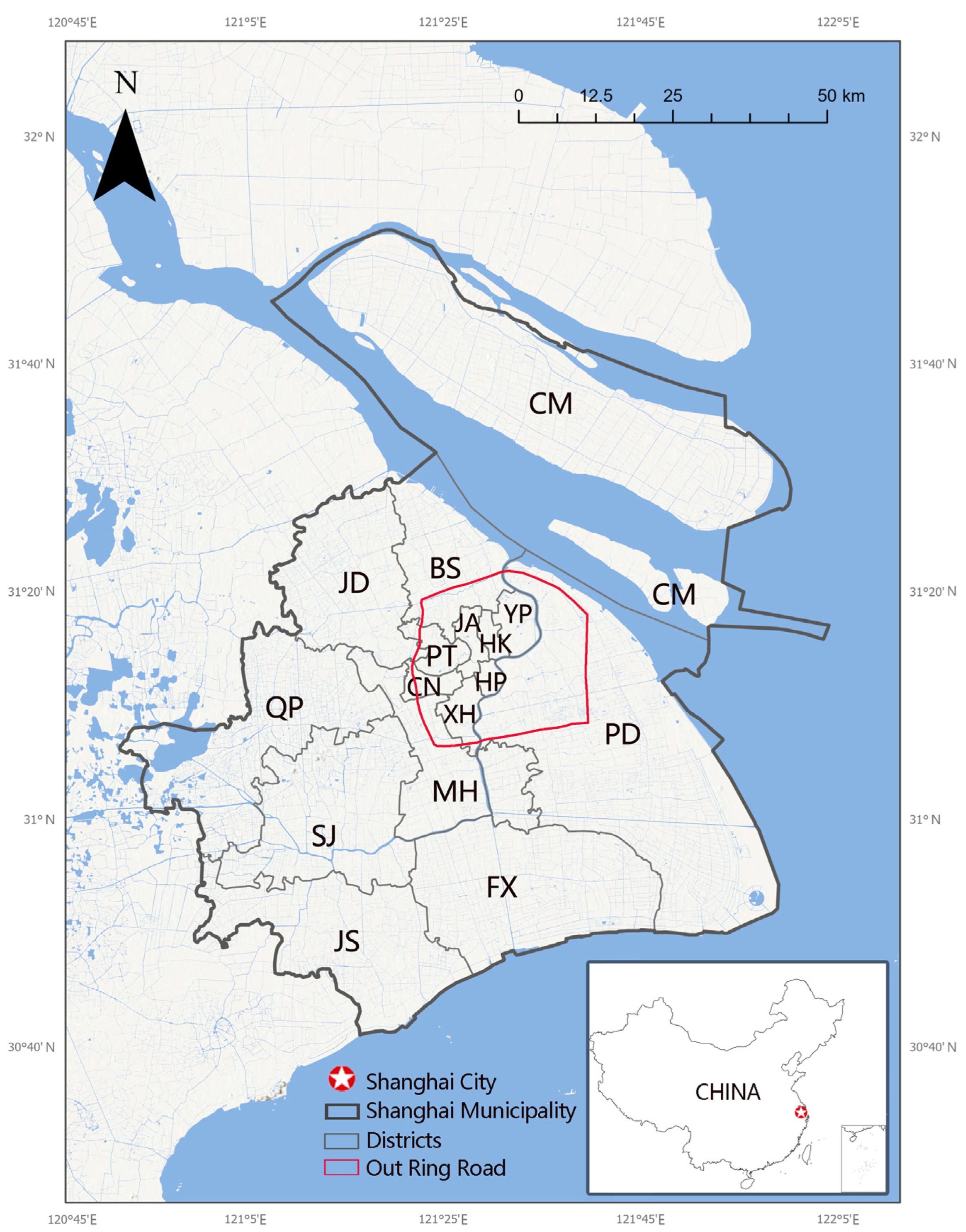

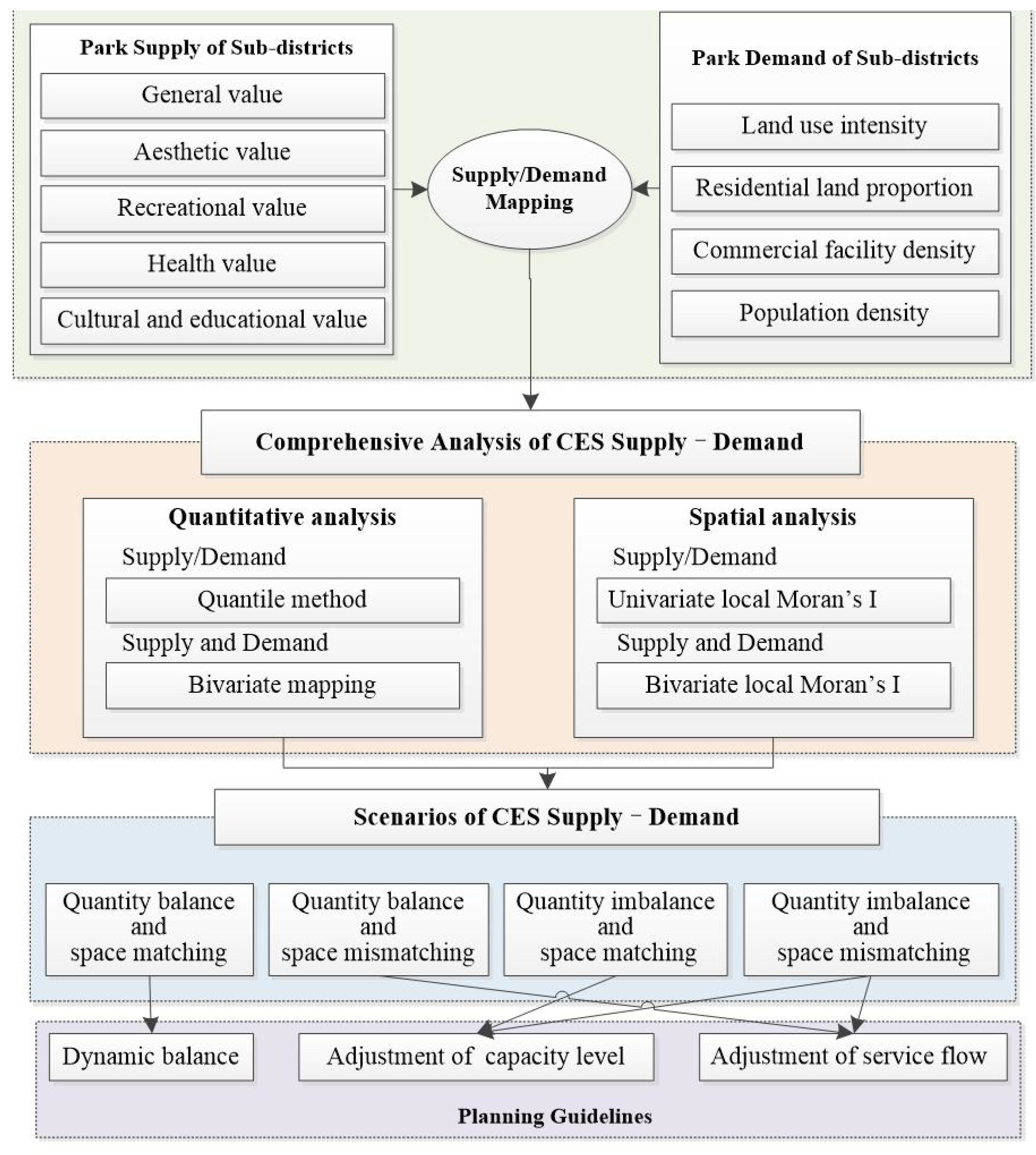
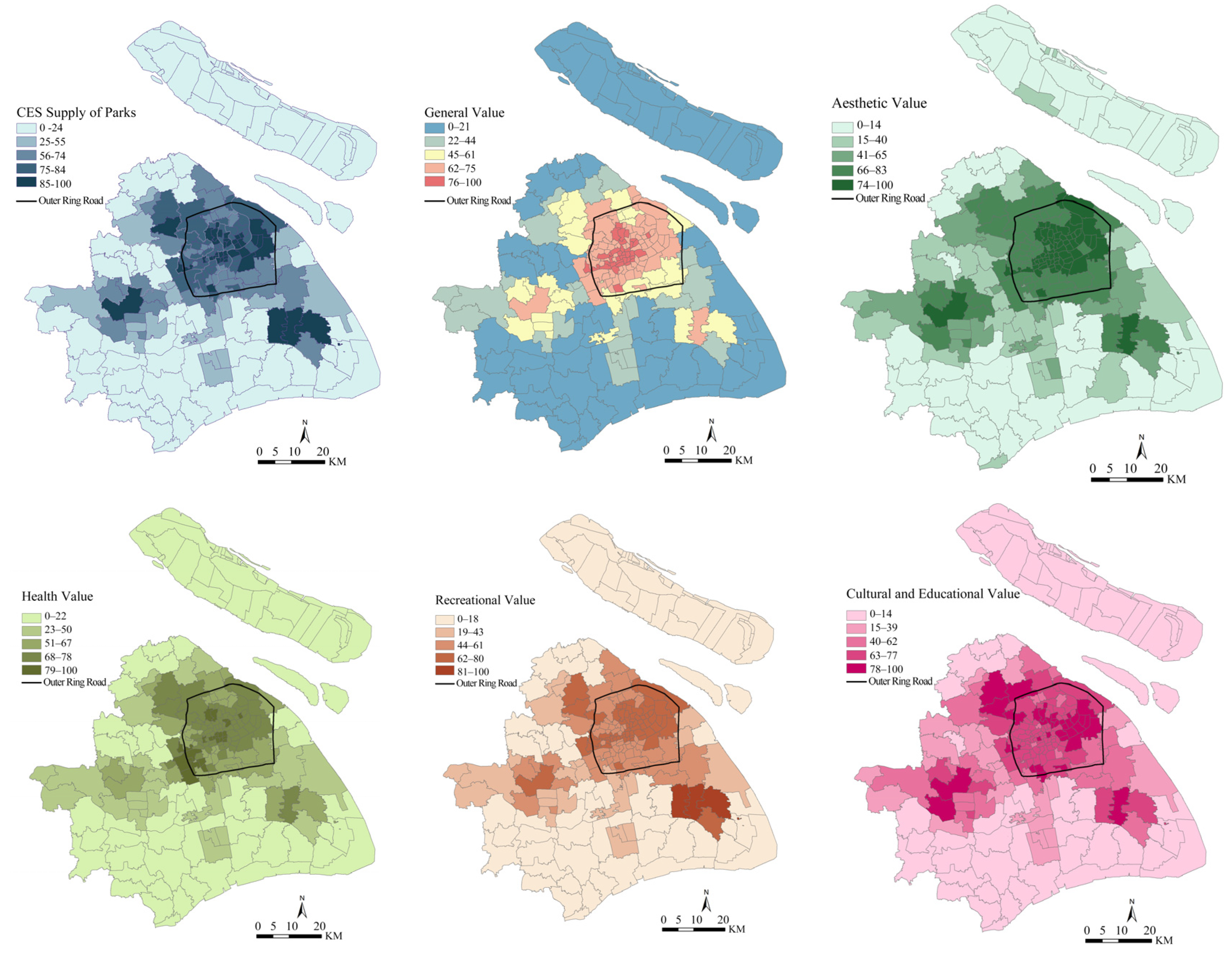
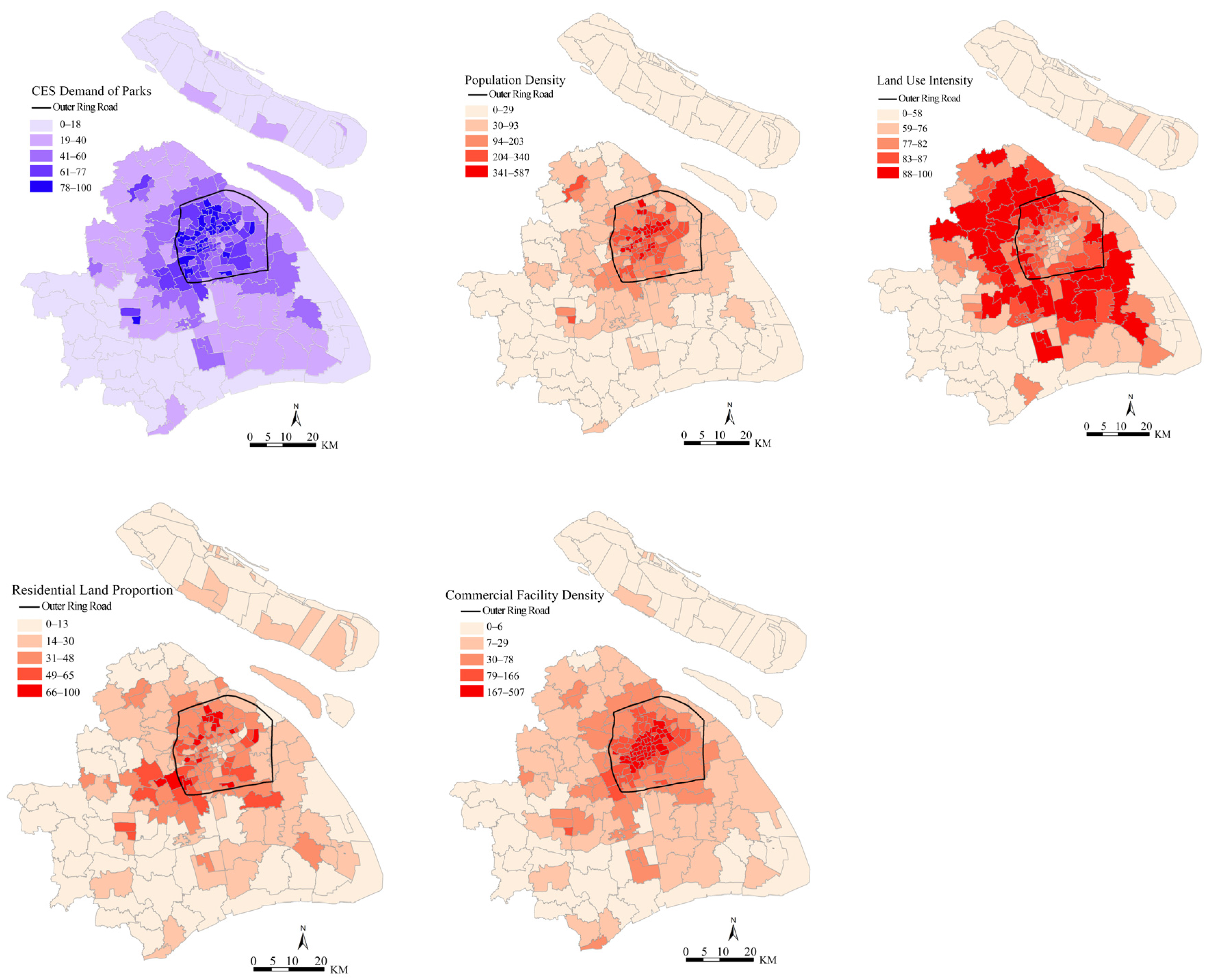
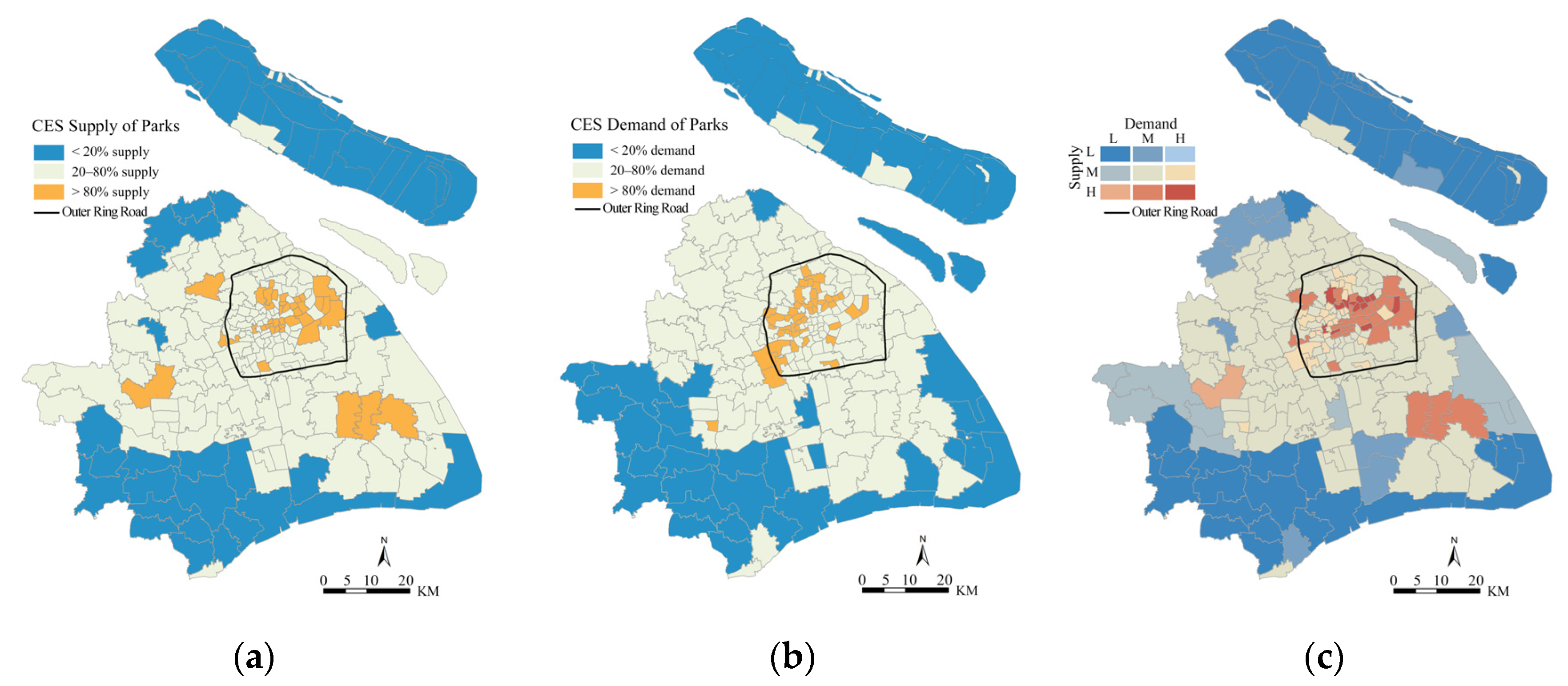


| Types of Parks | Features and Function | Number | Service Radius (km) | Area Range (ha) | Average Area (ha) |
|---|---|---|---|---|---|
| Comprehensive parks | Municipal and regional parks suitable for conducting various outdoor activities, equipped with comprehensive recreational facilities providing multiple services. | 41 | 3 | 3.55~140.3 | 28.28 |
| Theme parks | Parks with specific themes and corresponding service facilities, including zoos, botanical parks, historical parks, and heritage parks, etc. | 18 | 5 | 1.6~207 | 49.78 |
| Community parks | Parks equipped with basic recreational facilities, primarily serving residents within a certain community for nearby daily leisure activities. | 221 | 1 | 0.35~51.7 | 4.51 |
| Small-scale urban parks | Parks that are independently sited, relatively small in scale or varied in shape, conveniently accessible to nearby residents, and offer certain recreational functions. | 24 | 0.5 | 0.07~7.47 | 1.11 |
| Types | Formula | Variables | Descriptions | Units | Formula |
|---|---|---|---|---|---|
| Availability (AVA) | AVA = PAC + PCR + PSR | Park Area Per Capita (PAC) | The park area per capita of urban parks | m2 | where is the total area of urban parks, and is the total population of the city. |
| Park Area Coverage Rate (PCR) | The park coverage rate of urban parks | % | where is the total area of urban parks, and is the urban built-up area of the city. | ||
| Park Service Coverage Rate (PSR) | The coverage rate of parks benefits residents in geographical regions | % | where is the total area of the urban parks’ service radius, and is the urban built-up area of the city. | ||
| Accessibility (ACC) | ACC = PL × TCI | Park Location (PL) | The distance to the urban center | m | Calculated in ArcGIS 10.7, the network distance from the park centroid to the centroid of the urban built-up area was derived using |
| Transportation Facilities Coverage Index (TCI) | The number of transportation facilities (bus, subway, park) within an 800 m buffer of the park | - | where is the total amount of transportation POIs, and is the urban built-up area of the city. | ||
| Attractiveness (ATT) | where is the total area of the urban park’s service radius, and is the area of the sub-district where the park is located. | Park Environmental Quality (PEQ) | The status of the greening, scenery, detailed landscape, and quality of the park environment. | Grade | PEQ . |
| Park Green Coverage Ratio (PGR) | The vegetation coverage rate of urban parks | % | where is the total area of urban parks, is the total area of the vegetation in parks. |
Disclaimer/Publisher’s Note: The statements, opinions and data contained in all publications are solely those of the individual author(s) and contributor(s) and not of MDPI and/or the editor(s). MDPI and/or the editor(s) disclaim responsibility for any injury to people or property resulting from any ideas, methods, instructions or products referred to in the content. |
© 2025 by the authors. Licensee MDPI, Basel, Switzerland. This article is an open access article distributed under the terms and conditions of the Creative Commons Attribution (CC BY) license (https://creativecommons.org/licenses/by/4.0/).
Share and Cite
Yang, Y.; Jiang, L.; Ma, X.; Liu, S.; Wang, L. A Comprehensive Approach to Identifying the Supply and Demand of Urban Park Cultural Ecosystem Services in the Megalopolis Area of Shanghai, China. Land 2025, 14, 455. https://doi.org/10.3390/land14030455
Yang Y, Jiang L, Ma X, Liu S, Wang L. A Comprehensive Approach to Identifying the Supply and Demand of Urban Park Cultural Ecosystem Services in the Megalopolis Area of Shanghai, China. Land. 2025; 14(3):455. https://doi.org/10.3390/land14030455
Chicago/Turabian StyleYang, Ying, Li Jiang, Xiaoyan Ma, Song Liu, and Lihua Wang. 2025. "A Comprehensive Approach to Identifying the Supply and Demand of Urban Park Cultural Ecosystem Services in the Megalopolis Area of Shanghai, China" Land 14, no. 3: 455. https://doi.org/10.3390/land14030455
APA StyleYang, Y., Jiang, L., Ma, X., Liu, S., & Wang, L. (2025). A Comprehensive Approach to Identifying the Supply and Demand of Urban Park Cultural Ecosystem Services in the Megalopolis Area of Shanghai, China. Land, 14(3), 455. https://doi.org/10.3390/land14030455






